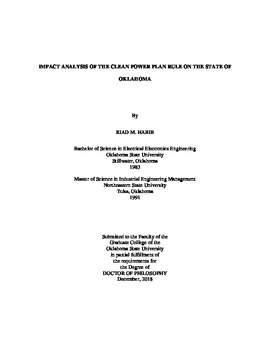| dc.contributor.advisor | Ferrell, Shannon L. | |
| dc.contributor.author | Habib, Riad | |
| dc.date.accessioned | 2019-07-19T13:33:33Z | |
| dc.date.available | 2019-07-19T13:33:33Z | |
| dc.date.issued | 2018-12-01 | |
| dc.identifier.uri | https://hdl.handle.net/11244/320937 | |
| dc.description.abstract | This research analyzes the potential economic, environmental, and social impacts of the Obama Administration's Clean Power Plan (CPP) rule on the state of Oklahoma. Climate change is a global concern, and the CPP was the Obama Administration's flagship climate policy intended to address the U.S. contribution to carbon mitigation. The goal of the CPP is to cut U.S. carbon pollution generated by the electric power sector by 870 million tons, or 32% below 2005 levels, by 2030. Oklahoma is responsible for reducing its CO2 emissions by 23.41% below the 2005 level under the proposed CPP. This research creates and evaluates the efficacy and costs of multiple generation scenarios to meet the state obligation. The methodologies used are: Linear Programming, Mixed Integer Linear Programming, and Cost-Benefit Analysis. Scientific data from the Environmental Protection Agency (EPA), Energy Information Administration (EIA), Southwest Power Pool (SPP), and Oklahoma's utilities provided the fundamental information needed to create and analyze the energy generation scenarios. The scenarios evaluated are: the Regional Haze Rule and Mercury Air Toxics Standards (RM) scenario, Beyond Coal (BC) scenario, Carbon Tax (CT) scenario and Generic Industry (GI) Scenario. The results of the research show that Oklahoma will meet its CPP emissions reduction target under the RM scenario with no additional cost incurred by the state. The research further demonstrates that phasing out coal generation by 2030 and replacing that capacity with wind and natural gas generation, as modeled in the BC scenario, is possible with no increase in electricity cost. This scenario would accrue approximately $4 billion more in net benefits when compared to the RM scenario. The BC and the CT scenarios are more resilient to water shortages and climate change that negatively affect the operation of thermal EGU. This scenario is less sensitive to environmental regulations and to possible future carbon taxes than the RM scenario. Based on the findings of this research, utilities and state regulators should consider supporting the federal CPP rule and the adoption of an energy generation portfolio similar to the BC scenario. | |
| dc.format | application/pdf | |
| dc.language | en_US | |
| dc.rights | Copyright is held by the author who has granted the Oklahoma State University Library the non-exclusive right to share this material in its institutional repository. Contact Digital Library Services at lib-dls@okstate.edu or 405-744-9161 for the permission policy on the use, reproduction or distribution of this material. | |
| dc.title | Impact Analysis of the Clean Power Plan on the State of Oklahoma | |
| dc.contributor.committeeMember | Ede, Kenneth F. | |
| dc.contributor.committeeMember | Kenkel, Phil | |
| dc.contributor.committeeMember | Stoodley, Scott Howard | |
| osu.filename | Habib_okstate_0664D_15949.pdf | |
| osu.accesstype | Open Access | |
| dc.description.department | Environmental Science | |
| dc.type.genre | Dissertation | |
| dc.type.material | Text | |
